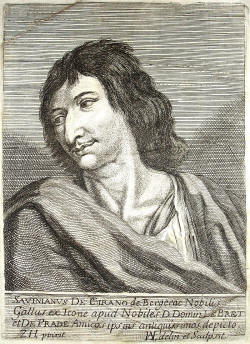

Queer Places:
Rue Cyrano de Bergerac, 95110 Sannois, France

The libertins were intellectuals who, in the face of Calvinist rigourism and Counter-Reformation propaganda, found in Greek and Roman scepticism materials and methods to debunk dogmas and develop ‘free-thought’ and, often by implication, to reinvent what was then labelled ‘pagan’ morality, sex. The best example is by another libertin, François de La Mothe Le Vayer, who extolled Greek love in his Hexaméron rustique (1670), having laid the foundations for it in his early and anonymous Dialogues (1630), and who was a friend of Molière, whose Don Juan is strongly marked by libertinage. Cyrano the homosexual cannot be taken in isolation. Well known at the time for his satirical plays (and a tragedy), more known today for his two famous cosmic voyages (L'Autre monde or Histoire comique des Etats et Empires de la Lune et du Soleil, in two separate parts, published posthumously in 1656 and 1661), he developed a scathing critique of French society.
His work has recently been repositioned within a network of homosexual friendships. Cyrano entertained a relationship with notorious libertin writers Charles Coypeau d'Assoucy and Chapelle, all three of them close to Molière and, in one way or another, students of Epicurean philosopher Pierre Gassendi, whose own passionate biographies of celebrated savants of the time point towards the importance of homosocial friendships in such circles. Whether an atheist or not, it is certain that Cyrano's rejection of Catholic dogmas regarding nature, society (he stood against absolutism) and morality found its source in his homosexuality as a subversive force. He had to exercise caution in concealing his ‘atheism’ (the sum total of the above) since such random accusation had cost the life of a forerunner, Lucilio Vanini, burnt at the stake in Toulouse, and brought to the pyre an effigy of fellow poet and homosexual Théophile de Viau, as well as it frightened sympathiser René Descartes enough to have him escape to Holland.
Yet, in the central episode of Les Etats du Soleil, Cyrano lifts the veil on his homosexuality: a comely youth appears, whose bodily beauty resonates through the universe, cosmetic appearance and cosmic arrangement being one in the raptured contemplation of male assertiveness. Cyrano does not rework here the commonplace of Renaissance ‘harmonic man’, as his philosophy is a materialistic one, steeped in atomism. The young man does not fulfil the function of an allegory for an orderly universe. It is an erotic vision, powerfully sexual and seminal, which signs, as it were, that unfinished manuscript, held back by the author at the time of his death.
The play by Rostand suggests that he was injured by a falling wooden beam in 1654 while entering the house of his patron, the Duc D'Arpajon. However the academic and editor of Cyrano's works Madeleine Alcover uncovered a contemporary text which suggests an attack on the Duke's carriage in which a member of his household was injured. It is as yet inconclusive whether or not his death was a result of the injury, or an unspecified disease.[47] He died over a year later on July 28, 1655, aged 36, at the house of his cousin, Pierre De Cyrano, in Sannois. He was buried in a church in Sannois. However, there is strong evidence to support the theory that his death was a result of a botched assassination attempt as well as further damage to his health caused by a period of confinement in a private asylum, orchestrated by his enemies, who succeeded in enlisting the help of his own brother Abel de Cyrano.
My published books: